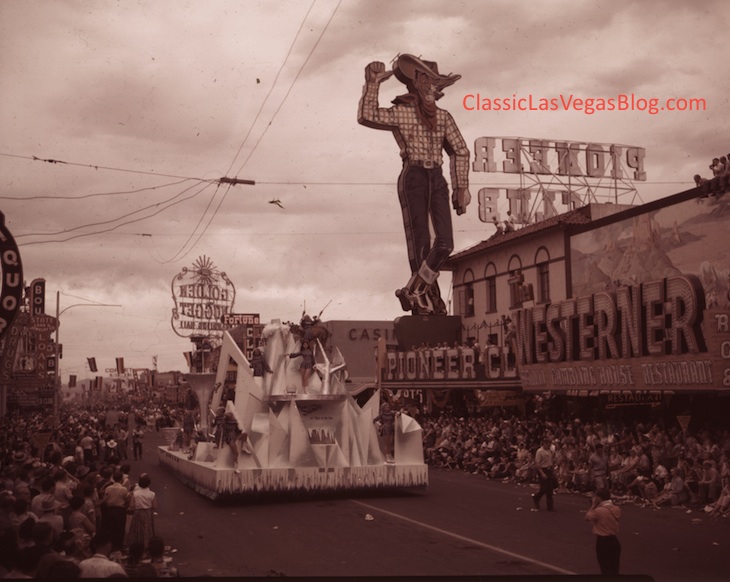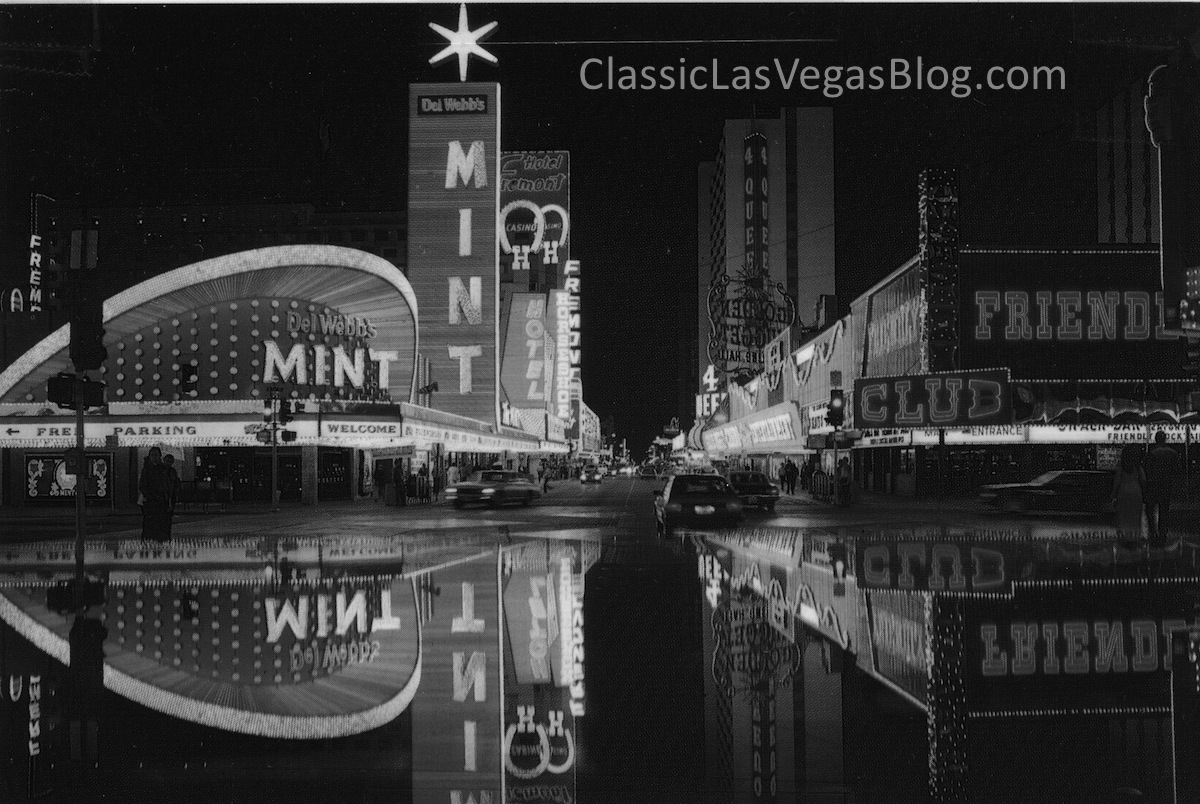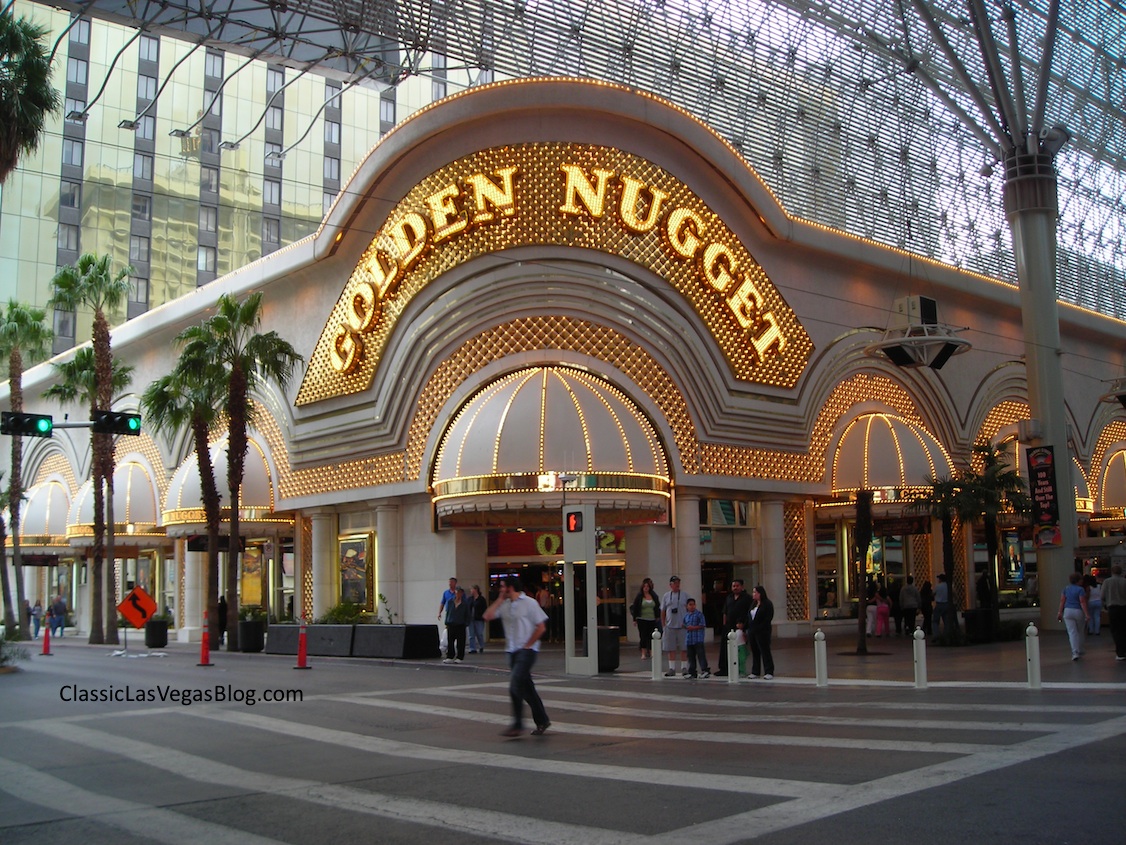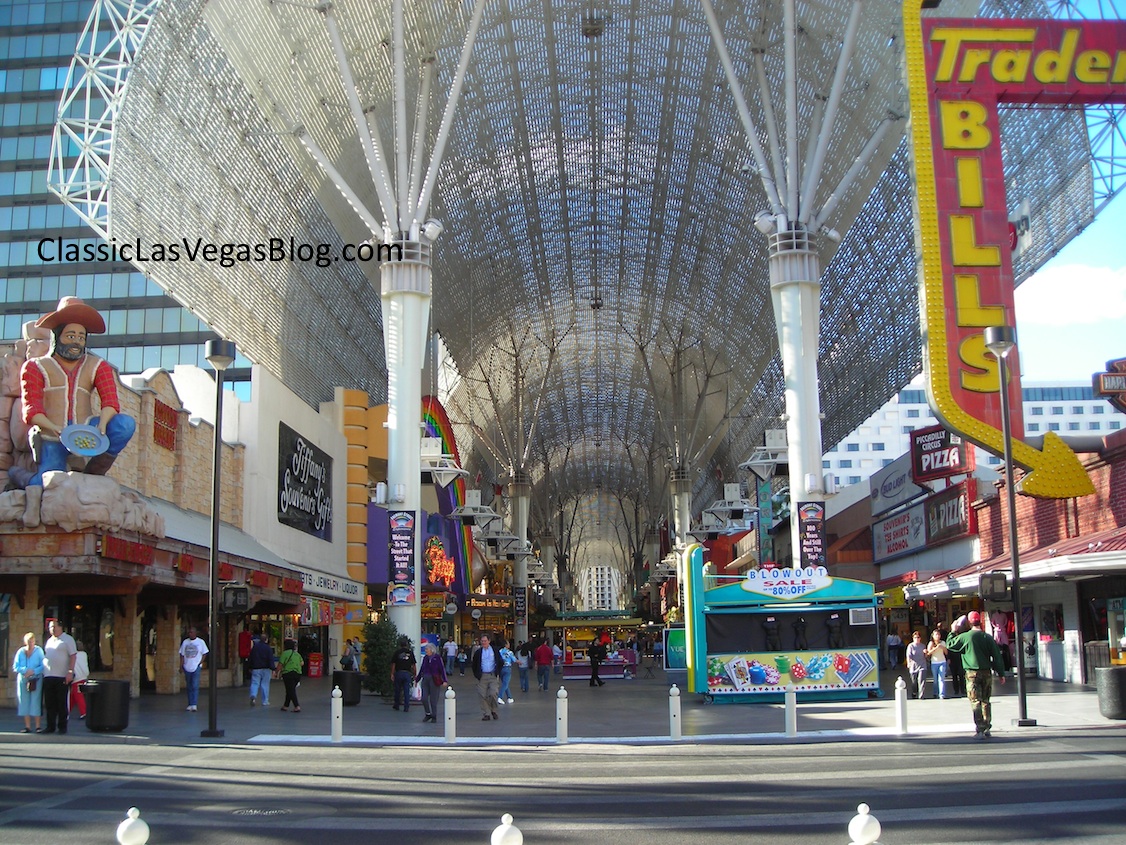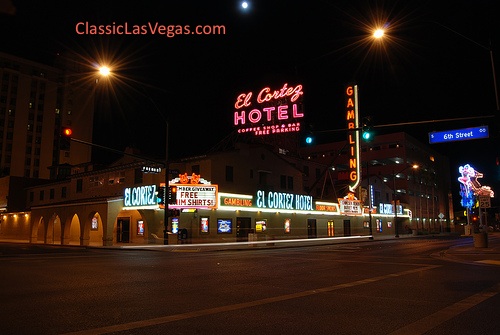With the debut of SlotZilla and the zip line over Fremont Street, we thought it was the perfect time to spotlight Fremont Street in our "Lost Vegas" series.
SlotZilla zip line on Fremont Street. (photo courtesy: Preferred Public Relations)
Fremont Street hasn't always looked like this. Before that damn canopy and "light show" that was meant to attract tourists looking for something different that they couldn't find on the Strip, Fremont Street was one of the most photographed streets in the world thanks to all the neon and its moniker, "Glitter Gulch".
Fremont Street 1970s courtesy of Joe Thiriot
Before what Andrew Kiraly rightfully describes as "A fickle, manic, mournful energy has been gathering tonight beneath the Fremont Street Experience canopy, magnetized by bad cover bands, cheap beer, tchotchke huts, and the hope for spectacle. Amid the shamble (grizzled beggars, drunk bros, tube-topped partygirls, sign-waving religious zealots), bubbles of bystanders form: Here’s a turf-dancing crew popping and locking, here’s a kid moonwalking in Off The Wall-era Michael Jackson drag, here’s a “living statue” performer who appears to levitate. No one lingers, no one watches long; it’s as though restlessness constantly prods." became the norm on Fremont Street, the blocks from Main Street to Las Vegas Blvd bustled with excitement, gamblers, high school students cruising on a weekend night to be see and be seen, and most of all, pulsating neon.
Whether you entered Fremont Street from the east or the west, you were engulfed in a canyon of neon and pulsating chaser lights.
Fremont Street neon courtesy of As We Knew It and Classic Las Vegas
Neon first came to Las Vegas on Fremont Street. In 1933, Thomas Young of the Salt Lake City based Young Electric Company was passing through town and thought Fremont Street could use some neon. He convinced the owners of the Boulder Club to install a neon sign that his company would design and an art form found its voice in the small town (and city) where all that night sky was unadulterated by light pollution making the signs stand out and be seen for miles around.
From its earliest days in the 1900s, Fremont Street was our Main Street. It was where the pioneering families originally lived, it was where they shopped, gathered for public events and met their friends. As the generations rolled on, it was where their children and their grandchildren cruised on weekend nights, "doing the donut", where they went to the movies (the El Portal, the Fremont, the Palace/Guild) and where they hung out (the Melody Lane, Corey's, the Blue Onion, Wimpy's and more).
Fremont Street 1950s
There were stores intermingling with casinos and no one thought twice about it. You could buy home goods, pottery and western wear for Helldorado. Back to school clothes could be bought at Sears, J.C. Penney's, Ronzone's. Women could shop for chic shoes at C.H. Baker, chic clothes at Chic Hecht's or Fanny's, for men there was Allan and Hanson's.
C.H. Baker Shoes
Chic Hecht Women's Store courtesy of UNLV's Special Collections
It was the home to the annual Helldorado Days parades which back in the 1950s rivaled the Rose Parade in popularity. For a weekend every May, Las Vegans returned to their western roots (whether they were from the West or not), donned cowboy (or cowgirl attire) and headed down to Fremont Street to watch parades, get thrown in the hoosgow or continue on down to nearby Cashman field for the rodeo and carnival.
Sands Hotel float, Helldorado beauty parade, 1950s courtesy of UNLV Special Collections
It was where casino owners like Benny Binion, John Kell Houssels, Jackie Gaughan and Sam Boyd built their kingdoms and their dynasties.
It was an active street that catered to tourists and locals alike. Wayne Newton got his start singing with his brother in the lounge at the Fremont, Kenny Rogers and the First Edition anchored the Horseshoe's lounge in their early years and Johnny Cash and June Carter were on the bill at the Mint.
Those casino owners knew how to cater to customers. Benny had the reputation of not turning down a bet and started the World Championship of Poker. Jackie started the "Fun Book" craze. Sam was known for hiring female dealers. They offered tourists and locals alike a different experience from the Strip and they did it without canopies, light shows and third rate tribute bands.
Fremont Street, courtesy of the Nevada State Museum, Las Vegas
But it wasn't meant to last. As the casino moguls aged, their properties aged as well. Their target markets were getting older, too. In the now-always quickening race for more profits, the properties suffered.
When the Boulevard Mall opened in the mid-1960s at Maryland Parkway and Desert Inn, it had what seemed a veritable ocean of free parking. Sears became one of the first stores to anchor the new mall. J.C. Penney's and Ronzoni's signed leases. Ronzoni's anchored the middle of the mall with Sears to the east and the Broadway to the west.
With the move to the suburbs, fewer people were living downtown. Now developers were catering to an ever-growing number of neighborhoods, Charleston Heights, Francisco Park, Twin Lakes and more. The Boulevard Mall was the shot across the bow of shopping down on Fremont Street. Within ten years a new mall had opened on Valley View, the Meadows, located across the street from where the first water that had made Las Vegas possible flowed. That water was long gone and the new mall was freeway close.
Steve Wynn finally gained control of the Golden Nugget in the mid-1970s and began renovating the property. It housed a four star restaurant and he lured Ol' Blue Eyes himself, Frank Sinatra, away from the Strip and into the Golden Nugget showroom.
In 1984, Wynn had the facade of the hotel completely changed. He was said to not like neon and thought it gave a sub-par reputation to the hotel.
Golden Nugget facade which made it a popular photo opportunity for journalists, tourists and filmmakers, courtesy of Carey Burke
Golden Nugget today, courtesy of Allen Sandquist
Like the Boulevard Mall, it was a shot across the bow that Fremont Street was about to change once again. in the 1990s, Steve Wynn helped spearhead a new idea after his original idea of a Venice-like canal didn't catch on. The idea of a canopy over Fremont Street began to pick up buzz. The idea was to close off the first five blocks of the legendary street to car traffic and make it an outdoor mall-like setting. The canopy would provide shade during the day and at night a blazing light show would entrance tourists with its different music shows.
Glitter Gulch was no more. The canyon of neon that had taken a body blow with the loss of the Golden Nugget sign could not sustain the-life threatening wound that was the lowering of Vegas Vic. In lowering the neon cowboy who had presided over the street for over forty years, his arm was immobilized and he no longer could swing it back and forth. Like his voice that used to say, "Howdy Pardner" every few minutes and the special occasion cigarette rings that would come from his mouth, his arm and glowing cigarette became part of his history that many no longer know.
The final trauma was the placement of the speakers for the music not only for the light show but also for the daily enjoyment of those who walked those five blocks of the street. The speakers made it next to impossible to frame a good, wide shot of the street and the remaining neon from street-level.
The huge city owned parking lot on the south side of the street just west of Las Vegas Blvd didn't blend in with the street at all. But worse than that, was the huge Neonopolis mall that took up the whole north block between Fourth and Las Vegas Blvd. Walled off from easily being accessible to those walking by and the large concrete front that made it totally uninviting except as advertising space, Fremont Street gave up its ghosts and, in many ways, its history.
Classic Fremont Street, courtesy of Joel Rosales, lostandfoundvegas.com
Modern Fremont Street, courtesy of Allen Sandquist
El Cortez keeps its history shining brightly, courtesy of Allen Sandquist
If you want to experience old school Fremont Street, we recommend visiting the El Cortez where Jackie Gaughan's friends and family are keeping not only his memory alive but the history of the casino as well.
They have done a great job of renovating the hotel and keeping that renovation in the spirit of its roots.
Maybe that's a lesson for the rest of Fremont Street as well.
Did you cruise Fremont Street after football games? Enjoy movies downtown or shopping downtown? Share your memories with us!
And for more history of Fremont Street be sure to check out this:









